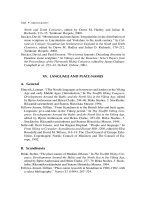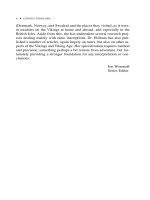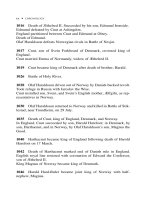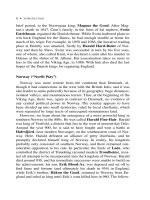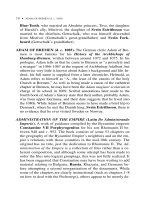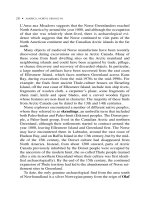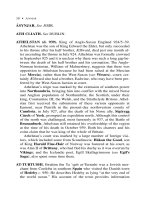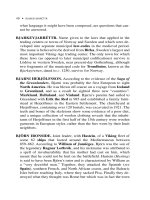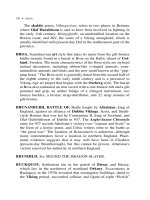The A to Z of the Vikings 14 doc
Bạn đang xem bản rút gọn của tài liệu. Xem và tải ngay bản đầy đủ của tài liệu tại đây (66.25 KB, 10 trang )
did not visit them. The main source of written evidence for Götaland in
the Viking Age is runic inscriptions carved on memorial stones. Among
the rune-stones from the two provinces are the famous Rök and Spar-
lösa stones from Östergötland and Västergötland respectively.
The relative primacy of Svealand and Götaland has long been de-
bated in Swedish historical scholarship. The traditional picture was
of Svear dominance and conquest, but in recent years, many histori-
ans have argued for the primacy of the Götar. The first king known to
have exercised power in both Svealand and Götaland is Olof Skötko-
nung, who was baptized at Husaby in Västergötland in 1010 (appar-
ently by an English bishop, Sigfrid), but it was not until after the end
of the Viking Age that a properly unified kingdom of Sweden
emerged.
GÖTAR. See GÖTALAND.
GOTLAND. Swedish island in the Baltic, whose present-day capital,
Visby, assumed its importance in the 11th century following the de-
cline of its predecessor, Paviken. During the Viking and early me-
dieval periods, Gotland was virtually independent of Sweden, and
this independence is also reflected in its distinctive cultural artifacts,
notably the Gotlandic picture stones that are decorated with mytho-
logical and heroic scenes. The limestone soils of the island provided
abundant fertile land for both growing crops and grazing animals.
Moreover, Gotland’s position in the Baltic made it a convenient step-
ping stone on the sea routes from Scandinavia to the East and the
South and an obvious distribution and market center for merchants.
During the Viking Age, its closest relations seem to have been with
the other Baltic island of Öland and the southeast Baltic coast. The
wealth of the island can be clearly seen in its large number of coin
hoards—over 700 Viking-Age hoards of silver are known from the
island—although their deposition may also reflect the relative vul-
nerability of the island to piracy. Indeed, the remains of about one
hundred forts (not all built in the Viking Age) have been found on
Gotland. The largest of these, Torsburgen, built perhaps in the fourth
century but still in use in the 10th century, covered an area of ap-
proximately 156 hectares. The Broa art style takes its name from the
bronze mounts found on the island.
108 • GÖTAR
GRÁGÁS. See LAW-CODES, ICELANDIC.
GRANI. Sigurd the Dragon-Slayer’s horse, which Sigurd loaded up
with gold after killing the dragon, Fafnir.
GREAT ARMY (OE micel here). Viking army that, according to the
Anglo-Saxon Chronicle, arrived in East Anglia in 866 and cam-
paigned in England well into the 890s. The Great Army, or Great
Heathen Army (OE micel hæ
ð
en here) as it is sometimes called, was
at the time the largest Scandinavian force to have raided in England,
and its arrival signified a shift from sporadic attacks to a long-term
campaign that resulted in the permanent Scandinavian settlements of
Northumbria, Mercia, and East Anglia. Following the settlement
of East Anglia, much of the army seems to have crossed the North
Sea and campaigned in the Carolingian Empire, returning when
Guthrum broke the Treaty of Wedmore in 885.
Although the Chronicle refers to the army in the singular, it con-
sisted of several distinct and shifting groups under a number of dif-
ferent leaders: Halfdan led the section of the army that settled in
Northumbria in 875; Guthrum was the leader of the group that settled
in East Anglia in 880; and the Chronicle also mentions leaders called
Ingware (see Ivar the Boneless) and Ubba (869), Bagsecg (870), Os-
cytel and Anund (875), and Hastein (892, 893–894). Archaeological
evidence for the presence of the Great Army has been recovered from
Repton and, more recently, Ingleby Heath, both in the English Mid-
lands. The contrast between these two sites, particularly in their
respective forms of burials, has been interpreted as reflecting two
distinct factions within the Great Army.
GREECE. See BYZANTIUM; GRIKKLAND.
GREENLAND. Large island in the North Atlantic. Some two-thirds of
Greenland lies within the Arctic Circle and a vast ice sheet covers
about 85 percent of its surface area. Gunnbjörn Ulf-Krakuson is be-
lieved to be the first European to have sighted Greenland. Both Ari
Thorgilsson and Adam of Bremen refer to the establishment of the
Norse colony of Greenland, but the so-called Vinland Sagas preserve
more details about its discovery and colonization. It is attributed to
GREENLAND • 109
Erik the Red, who is said to have found the island some 14 or 15
years before the Icelanders were converted to Christianity. Accord-
ing to these sagas, Erik named the country Greenland so that it would
attract colonists, but certainly there was relatively good pastureland
along the fjörds. In c. 985, some 25 ships of colonists are said to have
set out from Iceland to settle in Erik’s Greenland, but only 14 of these
arrived following a storm at sea.
The Norse colony of Greenland consisted of two main settlements
on its southwestern coast: the Eastern Settlement (Eystribygg
ð
) near
the southern tip of the island and present-day Julianehåb; and 650
kilometers to its north, the Western Settlement (Vestribygg
ð
), around
the modern capital of Nuuk (Godthåb). The Eastern Settlement seems
to have been the larger of the two with about 190 farmsteads, com-
pared to about 90 in the Western Settlement. In addition to these, a
group of about 20 farms located between the Eastern and Western
Settlements was known as the Middle Settlement, near to present-day
Ivigtut. The Norse population of Greenland has been estimated as be-
tween about 1,000 and 3,000 people in total, peaking around 1300.
Although the earliest settlers on Greenland were said to be pagan,
as yet no pagan Scandinavian burials have been discovered there.
Christianity is said to have reached Greenland through Leif the
Lucky. Several churches and Christian graveyards dating to the Late
Viking Age and medieval period have been identified on Greenland,
including that at Brattahlí
ðð
on Erik the Red’s farmstead. Flateyjar-
bók lists some 12 churches in the Eastern Settlement and 3 in the
Western Settlement. A Bishop of Greenland was appointed, based at
Gardar in the Eastern Settlement, in 1126; an Augustinian
monastery and a Benedictine monastery were also established in this
Settlement. The Greenlanders modeled their society on that they had
left behind in Iceland; for example, they too had an Althing, a con-
stitution, and a law-code. Like Iceland too, they later surrendered
their independence and recognized the Norwegian king (in 1261).
Cattle and sheep farming were the main economic activities of the
colonists, supplemented with hunting and fishing. The hunting
grounds around Disko Bay in the far north were known as Nor
ð
setr.
Confirmation of Norse exploration and activity in the north of Green-
land is provided by the Kingiktorssuaq stone. The Greenlanders
depended on imports for corn, timber, and luxuries, and in exchange
110 • GREENLAND
exported furs, hides, walrus ivory, polar bears, and falcons. The
colonists’ way of life was essentially European, and when the climate
of Greenland started to deteriorate in the Middle Ages (the so-called
Little Ice Age), this led to problems. Excavations and analysis of
skeletal and organic remains, such as those at Herjolfsnes (see Bjarni
Herjólfsson) have demonstrated that Greenlanders wore woolen
clothes rather than furs, like their Inuit neighbors, and their diet ap-
pears to have contained too little fat. This, rather than hostile rela-
tions with the Inuit (see skraeling), ultimately led to the extinction of
the Norse colony of Greenland. The Western Settlement appears to
have been abandoned by the middle of the 14th century, the Middle
Settlement by the end of that century, and the Eastern Settlement by
c. 1450. By the 15th century, contact between Greenland and her
Scandinavian neighbors had been lost, and nobody was sure if de-
scendants of the original settlers were still living on the island.
GREENLANDERS, SAGA OF (ON Grœnlendinga saga). This saga is
believed to have been written in Iceland in about or just before 1200.
The oldest surviving text is preserved in Flateyjarbók, which was
compiled in north Iceland between 1382–1395, and is therefore al-
most two centuries older than the original saga. In Flateyjarbók, the
saga is incorporated into another saga, that of King Olaf Tryggvason
of Norway. The beginning of the Saga of the Greenlanders was lost
in this process, and its first chapter in modern editions and transla-
tions is a later addition, taken from a version of the Book of Settle-
ments. See also VINLAND SAGAS.
GRETTIR’S SAGA (ON Grettis saga). One of the so-called Family
Sagas or Sagas of the Icelanders, Grettir’s Saga was written in Ice-
land at the beginning of the 14th century. It survives in four complete
manuscripts from the 15th and 16th centuries. The saga’s hero is the
Icelandic outlaw, Grettir Ásmundarson the Strong, who lived
c. 996–1031. According to the saga, Grettir was outlawed for a
killing and took refuge on the island of Drangey in Skagafjör
ður
(north Iceland). The saga is unusual in the prominent role played by
the supernatural, and there are some parallels with the Old English
epic Beowulf (for example, Grettir’s fight with the ghost, Glám).
Glám’s curse on Grettir ultimately led to his death.
GRETTIR’S SAGA
• 111
GRIKKLAND. Old Norse name for the northeastern Mediterranean
lands of the Byzantine Empire (see Byzantium). Viking-Age rune-
stones from central eastern Sweden contain more references to
Grikkland than to any other foreign country. The relative frequency
of these references presumably reflects the opportunities there for ac-
quiring wealth, whether it was in the form of trading, raiding, or mil-
itary service (see Varangian Guard).
GRIM KAMBAN. According to the Saga of the Faroe Islanders,
Grim kamban fled the tyranny of King Harald Fine-Hair of Norway
and was the first Norse settler of the Faroe Islands. However, his
Celtic nickname kamban suggests that he may also have spent time
in Ireland or the Hebrides.
GROBIN. Fortified Viking-Age settlement in present-day Latvia, prob-
ably identical with the Seeburg in Kurland that is mentioned in the
Life of St. Ansgar (see Ansgar, St.). According to this Life, the town
was captured by the Svear (see Svealand) c. 850. Certainly there is
considerable archaeological evidence for a Scandinavian presence in
the town: grave goods with parallels in both central Sweden and Got-
land have been discovered in the cemeteries around Grobin, and,
more recently, a Gotlandic picture-stone has been found there.
GROIX, ISLE DE. Island off the south Breton (see Brittany) coast in
present-day France. A ship burial, dating to the first half of the 10th
century, was found on the island’s headland. This is the only known
male Viking burial in France. A longship (see ships) measuring some
14 meters in length, containing the bodies of an adult male and an ado-
lescent, had been ritually burned and subsequently covered by an earth
mound, with two parallel lines of standing stones marking the passage
to the sea. Only metal fragments of the ship survived the funeral pyre—
iron rivets, nails, and some fragments of iron decoration from the stern.
The ship also contained a range of rich grave goods: weapons (swords,
spearheads, shields, and an ax), riding gear, gold and silver jewelry,
smith’s tools, farming implements, and ivory gaming pieces.
GULATHING (ON Gula
þþ
ing). Legal province in western Norway, es-
tablished c. 950. The law-code of the Gulathing is one of two surviv-
112 • GRIKKLAND
ing Norwegian law-codes and is preserved whole in a medieval man-
uscript, Codex Rantzovianus, dating to between 1250–1300, as well
as in a number of fragments.
GUNGNIR (“the swaying one”). The name of Odin’s spear, which
was made by dwarves known as Ivaldi’s sons according to Snorri’s
Skáldskaparmál. According to the Eddic poem, Sigrdrífumál, runes
were carved into the point of the spear. Gungnir is one of Odin’s main
attributes, and it was said that throwing a spear over opponents in bat-
tle dedicated them to Odin. Odin’s self-sacrifice, as described in Há-
vamál, also refers to his being wounded by a spear.
GUNNBJÖRN ULF-KRAKUSON. According to the Vinland Sagas,
the first Norseman to sight Greenland when he was blown off course
on a voyage from Norway to Iceland, some 60 years before Erik the
Red’s voyage to Greenland.
GUNNHILD (ON Gunnhildr). In Heimskringla, Gunnhild is said to
have been the daughter of Özurr Toti of Halogaland in northern
Norway. However, Historia Norwegiae provides the information
that she was the daughter of Gorm the Old and therefore the sister
of Harald Blue-Tooth of Denmark. Gunnhild is, however, chiefly
remembered as the wife of Erik Blood-Ax of Norway and the
mother of Harald Grey-Cloak. She ruled as Erik’s queen in York
and returned to Norway after his murder. Following Erik’s death,
she commissioned Eiríksmál in his memory. On her return to Nor-
way Gunnhild supported Harald Grey-Cloak’s and her other sons’
(there were six besides Harald) claims to the Norwegian throne, and
was therefore known as “the mother of kings” (ON konungamó
ð
ir).
She may be one of the few female poets of the Viking Age, although
just one half stanza is attributed to her, and this attribution is far
from certain. In the Icelandic sources, Gunnhild is depicted at best
as a manipulative and scheming woman (e.g., Heimskringla), and
at worst as a witch and a nymphomaniac (e.g., Njal’s Saga
and Egil’s Saga). Gunnhild and her sons left Norway for Orkney
after the death of Harald Grey-Cloak, and they are said to have har-
ried in the west until the last of Gunnhild and Erik’s sons, Gu
ðrøðr,
died c. 999.
GUNNHILD • 113
GUTHRUM (d. 890). Leader of the part of the Great Army that set-
tled in East Anglia, eastern England. Guthrum joined the army in
871, was involved in the conquest of Mercia, and, in 875, led a sec-
tion of the army to Cambridge, together with Oscytel and Anund.
Guthrum’s army systematically attacked the English kingdom of
Wessex in 878, forcing its leader, Alfred the Great into temporary
exile. However, Guthrum’s subsequent defeat at Edington was fol-
lowed by his baptism, alongside that of some of his men, and he
adopted the English baptismal name of Athelstan, with Alfred stand-
ing as his godfather. The two leaders also signed a peace treaty at
Wedmore, in which Alfred conceded East Anglia to the Scandina-
vian army. According to the Anglo-Saxon Chronicle, Guthrum then
went to Frankia and returned to England in 885, breaking the terms
of the peace of Wedmore. However, upon his defeat by Alfred in 886,
the treaty was renewed.
GYLFAGINNING (“The tricking of Gylfi”). Second part of Snorri’s
Prose Edda. Gylfaginning is written in the form of a dialogue be-
tween Gylfi, a Swedish king disguised as a traveler called Gangleri,
and three kings of the Æsir, named as High, Just-as-High, and
Third. The purpose of the dialogue was a contest of
wisdom, and in the course of Gylfi’s questioning, the three kings
provide what is probably the best account of Norse mythology,
from the beginning of the world, through descriptions and stories of
the gods, to the destruction of Ragnarök. Gylfi is prevented from
winning the contest by the disappearance of the three kings and
their hall at the end of the questions. However, the Æsir decide that
they should continue the deception and adopt the names of the gods
about whom they were talking, in order that they might be wor-
shipped.
– H –
HACKSILVER. Name given to cut up pieces of silver coins, arm rings,
and jewelry that is commonly found in Viking-Age hoards. The sil-
ver was cut up into pieces weighing standard amounts and was used
instead of coinage.
114 • GUTHRUM (d. 890)
HÆRVEJEN. See ARMY ROAD.
HAFRSFJÖRD, BATTLE OF (ON Hafrsfjör
ðð
r). Famous sea battle
fought off the Norwegian coast, now Havsfjørd west of present-day
Stavanger, by Harald Fine-Hair against an alliance of local chief-
tains and rulers. These included Erik, king of Hordaland; Sulki, king
of Rogaland; Kjötvi the Rich, king of Agder, and his son, the
berserker,
þ
órir Haklangr. An account of the battle is given in Heim-
skringla, where five stanzas of skaldic poetry composed by the poet,
Thorbjörn hornklofi (“Horn-Cleaver” = raven), are quoted. These ap-
pear to be part of a longer poem of some 23 stanzas, generally called
Haraldskvæ
ð
i, about Harald Fine-Hair.
The date of the battle is uncertain. While later Icelandic writers,
such as Ari Thorgilsson, date Hafrsfjörd to 870, modern historians
prefer a date c. 885–890. According to later Icelandic tradition, Har-
ald’s victory made him the first king of a united Norway, triggering
many Norwegians to seek out freedom from royal control in new
lands in the North Atlantic. In reality it seems that Harald’s kingdom
did not extend north of present-day Trondheim.
HAITHABU. See HEDEBY.
HÁKON JARL SIGURDSSON (ON Hákon jarl Sigur
ðð
arson)
(c. 940–995). Also known as Hákon the Great (ON inn ríki). Earl of
Lade in Norway c. 963–995 and the last pagan ruler of that country
c. 970–995. His father, Earl Sigurd, was murdered by Harald Grey-
Cloak, whom Hákon Jarl drove into exile c. 968 with the support of
the Danish king, Harald Blue-Tooth. Following the collapse
of Harald Grey-Cloak’s rule, Hákon Jarl and Harald Blue-Tooth
shared power in Norway: Harald ruled the southern part of the coun-
try, nearest Denmark, while Hákon controlled the west coast as Har-
ald’s subordinate and Trøndelag in his own right. In Heimskringla,
Hákon is said to have fought with Harald against the German em-
peror in 974 and to have been baptized following his defeat. Rela-
tions with the Danish king soured after Hákon renounced his new
religion and Harald forcibly attempted to reconvert the earl. How-
ever, Hákon won control of the whole country following his victory
against the Jomsvikings at the Battle of Hjörungavágr, and the
HÁKON JARL SIGURDSSON (
c
. 940–995) • 115
Danish kings were unable to reclaim their control or overlordship
until c. 1000.
Hákon’s rule is described in favorable terms in Heimskringla—the
harvests were good, herring filled the fjörds, and there was peace
throughout the country—but Hákon’s attitude to women was de-
scribed as “intemperate.” He was married, but is said to have taken
an unusually large number of concubines, sometimes for just a week
or two at a time. He maintained a large number of skalds at his court,
whose poetry (see skaldic poetry) provides important contemporary
witness to his rule. Most notable is the poem, Vellekla, composed by
the poet Einar Helgason, nicknamed skálaglamm (“scale-tinkle”).
Hákon’s reign was brought to an end by the arrival of Olaf Trygg-
vason in Norway in 995. Hákon fled to his mistress, Thora, who is
said to have hidden him in a pigsty on her farm near Melhus, south
Trøndelag (south of Trondheim). Shortly afterwards, Hákon was
killed by his slave, Kark, in return for a reward by Olaf Tryggvason.
HÁKON THE GOOD (ON Hákon go
ðð
i) (c. 920–960). King of Nor-
way c. 935–960, Hákon was one of Harald Fine-Hair’s sons and the
half brother of Erik Blood-Ax. He became king of Norway after
driving his half brother Erik out of the country with the support of
Earl Sigurd of Lade; Earl Sigurd was rewarded by being allowed to
retain control of Trøndelag. Hákon had been fostered and brought up,
as a Christian, at the court of King Athelstan in England and is there-
fore also known as Hákon A
ð
alsteinsfóstri (“Athelstan’s foster-son”).
Hákon is credited with reforming the district things, establishing a
naval force based on lei
ðð
angr and skiprei
ð
ur, and developing a bea-
con system to warn of attacks. Sighvatr
þþ
ór
ðð
arson’s Bersöglisvísur
praises Hákon for his “just and kind” laws.
Hákon’s nickname, “the Good,” refers to his active support of
Christianity in Norway: he invited missionaries (for example, the
English bishop Sigefridus of Glastonbury) into his kingdom and had
churches built. However, there was a pagan backlash against this at-
tempt to convert his countrymen, and the churches were burned down
and the missionary priests killed or driven from the country. In the
mid-950s, the sons of Erik Blood-Ax revolted, with Danish support,
against Hákon and he died, about five years later, from wounds sus-
tained in battle against them at Fitjar. He was buried at Seim, north
116 • HÁKON THE GOOD (
c
. 920–960)
of present-day Bergen. Ironically, the skaldic poem, Hákonarmál,
which was composed in Hákon’s memory, is full of pagan imagery.
HÁKONARMÁL. Poem composed by Eyvindr skáldaspillir, which
describes the last great battle of Hákon the Good of Norway, his
conversation with Odin’s valkyries, and his subsequent reception
into the Norse pagan hall for warriors, Valhalla. The battle is re-
counted in the epic fornyr
ðð
islag meter, while the rest of the poem is
composed in ljó
ðð
aháttr. Hakonarmál concludes with a sad reflec-
tion on the present enslavement of Norway at the hands of the sons
of Erik Blood-Ax and the Danish king, Harald Blue-Tooth. The
poem is preserved in Heimskringla.
HALFDAN (d. 877?). One of the leaders of the Great Army that ar-
rived in England in 865. Halfdan is first named in the Anglo-Saxon
Chronicle entry for 871, where he is said to have fought Æthelred of
Wessex and his brother, Alfred the Great, at Ashdown. Halfdan and
another “heathen king” called Bagsecg are there described as the
leaders of one section of the Viking army. Halfdan is next mentioned
in the Chronicle for 874, following the Great Army’s split after Rep-
ton. He is said to have wintered on the River Tyne in Northumbria
with a section of the army and to have raided among the Picts and
Strathclyde Britons, who inhabited present-day Scotland. In 876,
Halfdan and his men divided up Northumbria and settled down,
“plowing and providing for themselves.” Halfdan is not mentioned in
the Anglo-Saxon Chronicle after this date. A brother of Halfdan,
Ubba, is said in the Chronicle to have died in battle in Devon, Wes-
sex, in 878, and the Anglo-Norman historian, Simeon of Durham,
also claims that Halfdan and Ivar the Boneless were killed during
this raid. However, Halfdan has been identified with the Albann who
was killed at the Battle of Strangford Lough in Ireland in 877. In the
later legendary tales about Ragnar Lo
ðð
brók, Halfdan is said to have
invaded England with his brothers, Ivar the Boneless, Ubba, and
Björn Ironside to avenge his father’s death at the hands of Ælla of
Northumbria.
HALFDAN THE BLACK (ON Hálfdan svarti) (d. 880?). Norwegian
king whose saga is the second in Snorri’s Heimskringla. Very little is
HALFDAN THE BLACK (d. 880?) • 117
